|
Extracts of the short history of the
DUMBRECK'S of ABERDEENSHIRE & MORAYSHIRE
(with special thanks to William
Vincent Dumbreck
who compiled & researched the following)
See Roland
and Lynne Dunbrack at Mains of Dumbreck
See St. Mary's
Chapel

 | NOTE ANY ITEM IN
BLUE IS A LINK TO A PAGE
From this period parish registers are sometimes available but
they are generally incomplete. Relationships must therefore be confirmed from other
sources. There are very few death (mortcloth) entries, not surprising" in view of the
unsettled state of the country. Dumbreck names now appear for the first time in districts
far remote from Morayshire and Aberdeenshire.
A CHARLES "Captain in Colonel Archibald
Row his Regiment of Foot Guards" (21st. Foot now Royal Scots Fusiliers) was amongst
the officers of the regiment made honorary freemen of Aberdeen In 1894. He married
Elizabeth Ranken widow in Edinburgh in 1699, was made an honorary burgess of that city in
1701 "for several good services done by him to the interest of the town" and is
described as of the Edinburgh City Guards on his death in 1717. He left considerable
estate.
A WILLIAM appears in Aberdeen in 1757. On
25th August, described as ‘gardener in Craigtown’ he married Mary Anderson of
Linlithgow and became the progenitor of the more numerous Linlithgow branch of the family.
It is still represented in that town.
Alexander
Dumbreck had seven children by Margaret
Dunbar, James, Alexander, Archibald, Thomas, Mary, Christian and Jean. JAMES, bapt. at Boharm 12
Sept. 1674 was in Mains of Rothes in 1700. He had four children ‘by his wife
Elizabeth Leslie: Charles, Robert, James and Christian, some of whom were baptised in the
church of Dundurcus.
CHARLES, b. c. 1700 married Isobel Mitchell
at Dundurcus 25 Oct. 1726 and is described as ‘of Rothes’. He was the miller in
Mains of Rothes in 1734 and had died by 1760. He had five sons and one daughter; James,
Alexander, Thomas, George, John and Margaret.
Of the first three sons, only Alexander remained in the Rothes area;
James and Thomas
emigrated to Halifax, Nova Scotia their name changing to DUNBRACK / DUNBERACK
(possibly as a result of immigration). JOHN,
the youngest, bapt. Rothes 23 May 1736, appears in Edinburgh in 1762, when on 2 Feb. he
married Christian Noble, daughter of William Noble mason in Penicuik. The marriage entry
describes him as ‘stablers servant’ but in all the entries relating to the
baptism of his children he is called ‘vintner’. John’s connection with
Rothes is established by two entries in the Edinburgh Registers. A witness to the baptism
of his son James on 2nd Feb. 1765 was his eldest brother James (it was custom for the
sponsors to be of the same christian name as the child, described as ‘salmon fisher
at Spey’. The Rothes registers show that James lived at Coble-pot of Airndilly, on
the Spey opposite Rothes. The second entry is that of the marriage of his sister Margaret
to William Stables in 1769, where she is called ‘daughter of the late Charles
Dumbreck miller in Rothes". It is a likely assumption that John left Rothes on his
father’s death and took his young sister with him.
John became a very successful vintner and Innkeeper and
figured prominently in Edinburgh when the New Town was being built. In 1773 he owned the
King’s Head at the end of New Bridge (the first North Bridge) and in 1779 also
purchased the White Horse Inn at the Cowgate Port. While proprietor of the White Horse
John developed the coaching business belonging to it. In March 1781, under the heading
"In 4 days to London during the Summer" he advertised that "The Edinburgh
and London Fly would on Monday 2nd April set out from the White Horse at 2 o’clock in
the morning precisely and continue to do so every lawful day". He also ran the
Edinburgh and Aberdeen Fly, stage coach to Kelso and several coaches to Leith. In 1780
John also owned the Whale Inn at Newhaven. In 1790 he took over Dun’s Hotel at 59,
St. Andrew Square in the New Town and disposed of the White Horse. He was regarded by his
contemporaries as a man of advanced ideas who had greatly improved the hotel standards of
the time.
John had six sons and three daughters by Christian Noble:
William, James (d. in infancy), Charles, John, Thomas, Robert, Fanny, May and Josepha.
WILLIAM,
the eldest son, also opened a hotel at 35 St. Andrew Square, Edinburgh in 1790. When John died the
next year William took over both houses, which soon became well known as
‘Dumbreck’s Hotels’ and, spread into the intervening buildings. It was the
leading hotel of the New Town and is often mentioned in literature of the period e.g.
Stevenson’s "St. Ives". William retired from active management in 1825, to
attain the dignity of ‘William Dumbreck Esq. of South Coates’, a detached house
then standing in the country at the east end of Haymarket, Edinburgh. He sold the hotel
buildings in 1825 to the newly formed National Bank of Scotland for £13,000 (and 3,000
guineas compensation to the tenant). William had three sons and three daughters by his
first wife Catherine Bowie; John, William, Robert, Catherine, Christian and Forbes
and
by his second wife Sarah Keltie three sons and two daughters; Archibald, William, George
(d. as child) Alexander, Helen and Elizabeth. Go to Williams' page for an image
of what the Hotels looked like back in the 1800's.
JOHN (1799-1854) the eldest son was a writer
to the Signet in Edinburgh and had an only daughter Kate by his wife Euphemia Kinnear. The
second son WILLIAM (1800-1875) qualified MD at Edinburgh in 1828. He was
later examiner to the College of Surgeons. He m. 1828 Anne Bassanville and had one son
William and one daughter Margaret Alston. This last WILLIAM b. Edinburgh
1835 d. Lucknow 1858, also qualified MD Edinburgh and was surgeon to 1st. Royals at
Sebastopol in 1854. The third son ROBERT (1802- ?) was a hatter at 88,
Candlemaker Row Edinburgh, m. Christian Greig and had an only daughter Elizabeth b. 1824.
The fourth and fifth sons ARCHIBALD WILLIAM (1817-1848) and ALEXANDER
(1824-1881) emigrated to New Zealand and Australia respectively
and possibly have male descendants.
CHARLES, second son of John the vintner, b.
Edinburgh 11 June 1766, was admitted a burgess of the city in 1789, in right of his father
John, as "cutler at the upper end of Chalmers Street" . On his marriage to Mary
Cromar in 1808 he is, however, called "Mariner of Newhaven". He had six
daughters, Anne, Christina, Sally, Elizabeth, Catherine and Baillie and finally a son
John, b. Edinburgh 30 Oct. 1823. As the son of a burgess JOHN was admitted to
Heriot’s Hospital in 1831, entered in the school records as son of Charles Dumbreck
cutler’. He left the hospital in 1858 with the report "Conduct,
fair, talent and
attainments, tolerable". His father having died in 1837 he was apprenticed to a
silversmith but, that occupation proving disagreeable and the weight of his feminine
entourage too heavy, he ‘ran away to sea’. In 1854 he joined the Customs service
and was finally stationed and retired in Liverpool, where he died in 1905. JOHN
married in 1854 Eliza
Jane Craig of Dumfries, they had four sons, Charles (d. in infancy), James Craig, John
and William and five daughters, Mary, Elizabeth, Anne, Emily Maud and Christina.
JAMES
CRAIG DUMBRECK (1858-1935) went to the United States and there
became a political figure. He had two daughters, Mary and Christina (m.
Ledson).
JOHN, the second son, (1860-1941), was a
post office official and had an only son JAMES CRAIG, b. 1894, for many
years head of the Eastern Telegraph Company in Scotland. His only son JOHN, b.
1923, is a graduate of Glasgow University, now in the Russian Department of
Manchester University (John retired 1983).
The third son WILLIAM, b. Liverpool 11 Dec.
1866, d, 7 Nov. 1957, also joined the Customs service. He married 28 July 1892 Anne
Brannan, daughter of Thomas Brannan, late of Bray, County Wicklow, and had three
sons William Vincent, Stanley and James Craig, and three daughters Anne Dorothy, Isobel
and Hilda.
WILLIAM VINCENT
DUMBRECK, b. Liverpool 1 July 1893,
served with the Liverpool Scottish (Camerons) 1911-1917), Indian Army 1917-1923, Royal Air
Force 1938-1946. He married 15 July 1924 Nora Alice Luck, eldest daughter of Alfred Gray
Luck of Frant, Sussex, and had twin daughter and son, Jean Christina, and Ian
Robert. IAN ROBERT b. Hadlow, Kent, 28 Jan. 1927 is a serving officer of
the Royal Navy. He married 20 Nov. 1954 Fay Langrish, King of Tarkastadt, Cape Province
and has a daughter, Deborah Christian, b. Tunbridge Wells, Kent, 27 Aug. 1955. Also RODERICK
WILLIAM DUMBRECK b. Singapore, 21 Aug. 1957,
Alice Polly Dumbreck b. East Peckham, Kent 9 April 1960
and Hamish Munro Dumbreck b. 3 Sept. 1964.
JOHN, third son of John the vintner, b.
Edinburgh 25 Mar. 1768, took over his father’s chaise hiring business and established
himself as a reputable coach-builder in West Register Street, Edinburgh. He is referred to
in the account of Shelley’s visit to Edinburgh in 1813 as "the Edinburgh
coach-maker who had repaired the private carriage". He married 1797 Mary Cossar and
died in 1830 without issue.
THOMAS, fourth son of John the vintner, b.
Edinburgh 17 Mar 1769, joined the Excise service in 1802. He was stationed in Aberdeen in
1805, Edinburgh in 1818 and was successively Collector at Argyle South, Perth and Glasgow,
retiring to Edinburgh in 1843. By his wife Elizabeth Sutherland he had a son DAVID,
b. Aberdeen 1805, MD Edinburgh 1830, who joined the Army Medical Service. He was in the
Crimea, became Inspector General of the Medical Services 1864, honorary physician to the
Queen 1865, K.C.B. (Knight Commander of the Bath) 1871. He died at Florence in 1876. By
his wife Elizabeth Campbell Gibson of Leith, m. 1844, he had issue an only son SUTHERLAND.
Thomas may have had another son - William born about 1808, more details are
described on Thomas
Dumbreck's page .
ROBERT, fifth son of John the vintner, b.
Edinburgh 13 Nov. 1774, was admitted a burgess of the city in 1830 in right of his father
John, innkeeper, as ‘late grocer’, No other record of him has been traced.
An un-placed member of the family (until 1999) was WILLIAM
FRANCIS MAXWELL DUMBRECK, whose service
record shows him b. Edinburgh 1790. He joined the Royal Navy 1802, serving in H.M.S.
Defence at the Battle of Trafalgar (1805), and H.M.S. Victory at Corunna, invalided
out in 1814.
He joined the Excise service in 1824 and was posted to the care of ‘Collector
Dumbreck’ at Perth and transferred to Glasgow in 1825 when qualified. He married his
first wife Jane Inglis of Lasswade in 1816 and his second wife Margaret McNicol of
Glenarchy in 1820 having a son by each wife. In 1825 he lived at the address in
Candlemaker Row, Edinburgh of Robert the Hatter.
DUMBRECK ARMS
The earliest Scottish armorial MS., the Forman-Workman MS.,
of circa 1562, shows the arms of "Drumbrak of that Ilk" as an otter seizing a
salmon, with two fleur-de-lys in chief, (see reproduction on home page), but at the date of this MS the
line ‘of that Ilk’ had died out with THOMAS DUMBRECK of DUMBRECK, killed
on the 10th September 1547at the Battle of Pinkie. The coat suggests
a connection with Meldrum of that Ilk (whose lands adjoined Dumbreck), which has "a
demi otter sable issuing from a fess wavy", with the fleur-de-lys as cadency marks
for the Orton branch. There is another early reference to an otter coat in the armorial MS
of Sir Patrick Home, where a ‘wolf passant’ is erroneously blazoned as an
‘otter sable’.
The Seton armorial of 1591 and the Balfour MS of c. 1640 both
give ‘a wolf transfixed with a dagger hilted gules’ and Nisbet’s
"System of Heraldry" of 1722 states "With us the surname of Dumbreck
carries: Argent, a dagger thrust into the back of a Wolf passant sable (Workman MS.)".
Some later writers have a ‘bear sable’ and in 1830
Robson’s "British Herald" gives "DUMBRECK (Edinburgh). Ar. a wolf
passant sable transfixed with a sword ppr. within a bordure gules - Crest, a dexter hand
holding a sword in pale and on the point thereof a boars head couped ppr. Motto
"Nocentes prosequor".
DRUMBRECK (Drumbreck, Scotland). Ar a bear
sa. with a skean piercing his back and coming out under his belly handle gu. blade
az."
The ‘bordure gules’ in Robson’s Edinburgh
blazon indicates a third son and it undoubtedly refers to arms used by JOHN (1768-1830)
the coach-maker in West Register Street, who would be quite familiar with the rules of
heraldry as coaches bore the crest of the family to which they belonged.
There are like arms attributable to his brother WILLIAM
(1763-1837) and his father JOHN (1736-1791) on a seal. It also appears on plate or seals
of’ THOMAS (1769-1856), JOHN (1799-1854) and JOHN (1823-1905) and has descended to
the present generation.
The arms have never been entered in the ‘Public Register
of all Arms and Bearings in Scotland’ as required by an Act of 1672. They are however
granted in England by Somerset Herald to RICHARD in 1926.
There is no armorial evidence in the buildings of Dumbreck or
Orton to confirm either coat. Hopes that confirmation might be obtained from seals on
deeds signed by JOHN of Orton between 1611 and 1632 came to nothing as no seals are
attached to the deeds.
NOTES
References in the text are to official Scottish records
RGS = Register of the Great Seal
RPC = Register of the Privy Council
KPS = Register of the King’s Privy Seal
LHT = Accounts of the Lord High Treasurer
ER = Exchequer Rolls.
The present Mains of Dumbreck estate in Aberdeenshire consists of five
farms - Mains, Newseat, Milltown, Alehouse and Mill. It lies between two streams,
the
Bronie Burn and the Yowlie Burn, and is in gentle rolling country, very bare except for
the trees in the old burying ground and around the houses and farms. It is about 1 mile
from Pitmedden, the nearest station being Logierieve and since 1731 belongs to Gordon
College, Aberdeen.
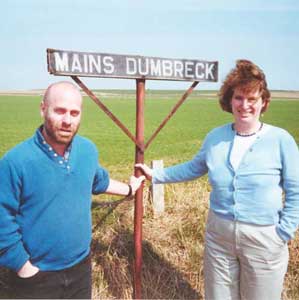
Roland Dunbrack and Sister Lynne Dunbrack on a visit 2001
from the USA
Orton, the home of the Moray branch, is in the Spey valley
about 5 miles north of Rothes, on the road and railway from Keith to Elgin. The house
stands between the road and the Haugh of Orton, the latter here being about one-third of a
mile wide. The present building is basically a Scots tower of four or five stories, around
which extensive additions were made in 1786 and 1848. The estate comprises the farms
of’ Garbity Mains, Home Farm, Mill and Bruntlands.
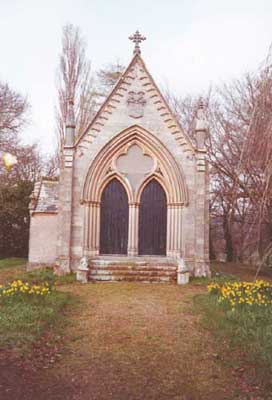 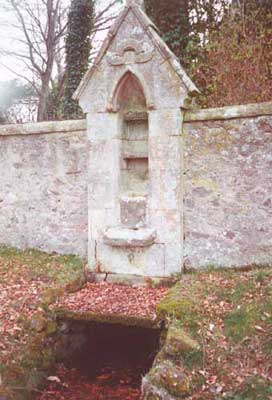
St. Mary's Chapel and the Holy Well at Orton
On the northern boundary of the
estate, adjoining Inchberry, was formerly a chapel and Holy Well, objects of pilgrimage
before the Reformation. A mausoleum designed as a small Gothic chapel was erected on the
site in 1844 by Wharton-Duff, the then owner of the property. The family was buried in it
until 1940. Norman foundation stones were found on the site.
|
Extracts from ‘The Book of the Old
Edinburgh Club'
Vol.: X1V (1925)
SOME INNS OF THE EIGHTEENTH CENTURY
kindly supplied by John
Dumbreck (Cheadle, Cheshire)
........... suitable roadster, which was to serve all the
way.’ Chambers adds that when Charles x. in 1639
‘ had made his first pacification with the Covenanters, and had come temporarily to
Berwick, he sent messages to the chief lords of that party, desiring some conversation
with them. They were unsuspectingly mounting their horses at this inn in order to ride to
Berwick, when a mob taught by the clergy to suspect that the king wished only to wile over
the nobles to his side, came and forcibly prevented them from commencing their designed
journey.’
It is Chambers, too, who declares that the White
Horse ceased to be an inn ‘ from a time which no oldest inhabitant of my era could
pretend to have any recollection of.’ That such a suitable inn as the White Horse
appears to have been should have thus fallen into disuse may seem strange, but as little
traffic in the early coaching days went by the East Road, travellers no doubt found it
more convenient to lodge at the inns at the Netherbow and Cowgate Ports where the coaches
by the Mid Road had their headquarters. Notwithstanding the fact that the principal inns
were at the gates of the city, one innkeeper, at any rate, John Somervell, had his
establishment in the middle of the eighteenth century at the foot of the Canongate,
although there is no clue as to which building he occupied.
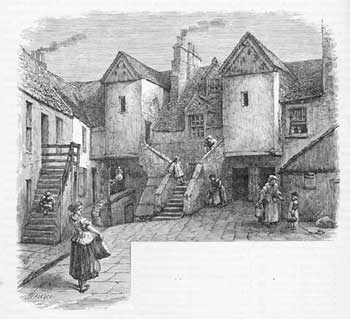
Engraving courtesy of Peter Stubbs
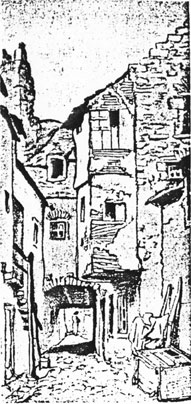
|
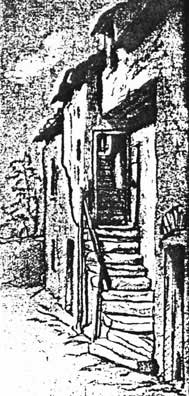
|
CANNONGATE
ENTRANCE |
STAIR LEADING
TO HALL |
WHITE HORSE INN, BOYD'S CLOSE
At first Somervell seems to have been a gunsmith
in the Canongate, and under that designation we find him advertising in December 1736
‘a good coach and six stout horses to set out for London or Bath.’
Besides
opening an inn, he appears to have developed the coaching business, for in July 1754 he
announced that another London stage coach‘ a new genteel two-end glass machine‘ would set out from his house. This coach was ‘drawn by six horses, with a
postillion on one of the leaders.’ In the eighteenth century the inns located
immediately without the Netherbow Port were a favourite rendezvous for travellers.
Here
gentlemen from London, York, Newcastle, and other English towns rubbed shoulders with East
Lothian farmers and Border merchante; here heavily laden carts from many towns and
villages were housed for the night; and hers horses could be shod and chaise or cart
repaired. The most notable inn in this locality was the White Horse, which, by the way, is
often confused with the inn of the same name at the foot of the Canongate.
The buildings in which this inn was carried on
had been used for stablers’ premises in the reign of Charles r., for in the List of
Owners of Property in Edinburgh in 1635 James Hamilton, Stabler, is mentioned as having
premises on the west side of the close which, in later days, was named Boyd’s Close.
In his memorials of Edinburgh, Sir Daniel Wilson describes the premises as ‘directly
opposite to the site of St. Mary’s Chapel in St. Mary’s Wynd on the west side,
where it contracts in breadth, a few yards below the Nether Bow.’ In the eighteenth
century the inn was invariably described as ‘at the head of the Canongate.’
There were two entrances, one from the Canongate and the other from St. Mary’s Wynd.
In the second half of the eighteenth century the inn was owned by James Boyd, during whose
occupancy it acquired literary fame. As we are reminded by a tablet affixed to the
building occupying the larger part of the site of the hostelry, it was ‘Boyd’s
Inn at which Samuel Johnson arrived‘ on ‘14th August 1773 on his memorable
tour to the Hebrides’, and here it was that, later in the evening, Boswell ‘exulted in the thought‘ that he now had his hero ‘actually in
Caledonia’, while Johnson embraced him cordially. But there is no need to retail the incidents of
Johnson’s stay at Boyd’s Inn, for they are well known. Boyd occupied the
premises before stage coaches became common, but, like others of his class, he sometimes
arranged to find accommodation for passengers who desired to travel by coach.
For
instance, on 11th May 1761 he publicly announced that ‘a mourning coach with six
able horses‘ was about to set out for London, and that passengers could obtain seats
by applying to him. In 1771 the White Horse was described by one who had stayed there as
‘crowded and con - fused', the master living in the stable, the mistress ‘not equal - to the
business'. In 1779 Boyd sought relief from his arduous labours by
letting the inn, as we learn from the following advertisement:-
‘To be let immediately and entry to at
Whitsunday next for such a term of years as shall be agreed upon that large commodious and
well - frequented inn at the head of the Canongate, called Boyd’s Inn, consisting of
two dining-rooms, a small outer room or parlour, 13 bedrooms and closets, besides
servants’ bedrooms, a small writing-closet, a convenient large kitchen and larder,
wine cellar with catacombs, coal and ale cellars; together with stables for upwards of 50
horses wherein are 40 stalls; as also backyard, pump well and coachhouse, which will
contain four or five carriages, and a convenient poultry house and other offices. The loft
above the stables will hold between two and three thousand stone of hay, and there is an
excellent corn loft. The premises are contiguous having free ish and entry from the
Canongate and from St. Mary’s Wynd'. The reputation of this inn is well known
having for these 30 years past been frequented by noblemen and gentlemen of the first
rank. For further particulars apply to Mr. Boyd the proprietor'.
The inn was let to John Dumbreck,
who had previously been in the service of Boyd, but had left to begin business for
himself. Dumbreck is described in Williamson’s Directory of 1773-74
as vintner at the King’s Head,’ at the end of the New Bridge'. These
premises, however, he relinquished on becoming tenant of the White Horse. Dumbreck
was also proprietor of an inn at Newhaven known as the Whale. A marked feature of Dumbreck’s
tenancy of the White Horse was the development of the coaching business. In March 1781,
under the heading of ‘ In Four Days to London During the Summer,’ it was
intimated that the Edinburgh and London Fly would on Monday, 2nd April, set out from the
White Horse at two o’clock in the morning precisely, and continue to do so every
lawful day. In July 1782 the hour of departure was altered to one o’clock. The White
Horse’ was also the place of departure of the Edinburgh and Aberdeen Fly, likewise of
a stage coach for Kelso, and several for Leith. Dumbreck’s occupancy
of the White Horse, however, was brief, for on 8th April 1790 he intimated to the public
that he was removing at Whitsunday to Dun’s Hotel at the south-east corner of St.
Andrew Square. The next tenant of the White Horse was Duncan M’Farlane, who had
previously been proprietor of the White Hart in the Pleasance, and more recently of Dumbreck’s
inn at the ‘end of the New Bridge.’ M’Farlane signalised his entry by
repairing the building, and by extending the coaching business. In addition to the coaches
already mentioned, the White Horse became the headquarters of the Stirling Coach, the
Jedburgh Ply, and the Berwick Diligence. The last mentioned, which carried three
passengers, ran by way of Haddington and Dunbar, the East Road now coming into favour
through the opening of the Pease Bridge. M’Farlane died about 1795, for later
references to the White Horse refer either to Mrs. M’Farlane, or Walter
M’Farlane, probably his son.
Another noted inn at the head of the Canongate
was the Black Bull, probably situated either in Bell’s or Gullan’s Close.
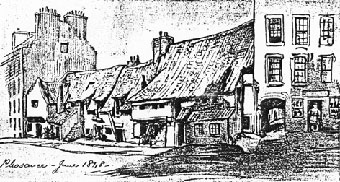
BLACK BULL INN (on right)
In the latter half of the eighteenth century
this inn was owned by James Robertson, who in March 1772 tried to let it, as we learn from
the following advertisement:
‘ To be let for one or more years and entry
to it at Whitsunday next that well-frequented house, with garrets and cellars, and the
stabling and coachhouses thereto belonging at the Black Bull, head of the Canongate. The
house is well lighted and of easy access, having an entry from both the head and back of
the Canongate, with good water in the coachyard and other conveniences. The whole very
centrical for business, particularly for postchaises and hackney coaches, which has been
carried on in this place for many years past. N.B. If a proper tenant does not appear for
the whole, the subjects will be let separately.
......there was storage for about four thousand
stones of hay. The upset price was £600, the ‘ proven rent ‘ being £66
sterling. Duncan M’Farlane afterwards became proprietor of a tavern and hotel on the
west side of Bridge Street. Here, in February 1789, by authority of the Lord Provost and
Magistrates, he placed on the street a coach and post-chaise for the convenience of
revellers, who after midnight had to pay double fare. In June 1790 M’Farlane removed
to the White Horse Inn at the head of the Canongate. At one time M’Farlane occupied
the White Hart, Pleasance, from which he appears to have gone to Balfour’s
Coffee-house, which stood on the south side of the High Street, opposite the Royal
Exchange. He afterwards became tenant of an inn at South Queensferry. In 1790 he was the
occupant of the large house in Adam Square, from which the London Fly (by Berwick and
Newcastle) and the Jedburgh Diligence set out. Another of the inns in this locality was
the White Hart, which is variously described as being situated ‘ at the foot of the
Pleasance ‘ and ‘ near to the Cowgate port.’ In the ‘sixties of the
eighteenth century it was in the possession of Mr. Laing, but in 1772 was taken over by
James Dun, who previously had kept an inn at the head of the Horse Wynd. Dun ran a coach
to Newcastle in opposition to one that set out from the Black Bull at the head of the
Canongate. It carried four inside passengers, and proceeded, three times a week, by the
Mid Road, reaching its destination on the same day that it left Edinburgh.
In 1773 the Newcastle Flying Post Coach, as it
was called at this time, changed its route, going instead by way of Kelso and Wooler. This
coach after-wards journeyed to London, accomplishing the entire distance in four days.
The fare to Newcastle was 31s. 6d, and to London £4 14s. 6d. From the White Hart Dun
migrated to the New Town opening, in 1777, a larger, and certainly a more pretentious
establishment at 39 St. Andrew Square, which was known for long as Dun’s Hotel. Here
were organised dancing assemblies, which drew together the elite of the city. Many
distinguished visitors to the city stayed at Dun’s Hotel, including Edmund Burke,
Samuel Rogers the poet, and the Piozzis. The next tenant of the White Hart was Duncan
M’Farlane, ‘ late Innkeeper at the head of the Horse Wynd.’ From the White
Hart in M’Farlane’s time there departed the London Fly which travelled by the
East Road; also the Glasgow Diligence which went by Linlithgow and Falkirk. M’Farlane
also issued tickets for those who wished to travel by the coach from Kinghorn to Dundee,
application for which had to be made twenty-four hours before the time of setting out at
Kinghorn. In 1782 M’Farlane left the White Hart and became proprietor of the Red Lyon
in the same street, after which, as already mentioned, he was owner of the inn at ‘
the end of the New Bridge ‘ vacated by Dumbreck. M’Farlane was
succeeded in the White Hart by William Paterson.
A third inn which stood outside the Cowgate Port
was owned about 1760 by John Sharp, ‘ Stabler in the Pleasance, Postmaster of
Canongate.’ Sharp seems to have been a man of substance. In 1762 he possessed the
parks of Innerleith as well as others near ‘ Sommervel house ‘ and ‘ two at
Kellies,’ which were advertised for grazing horses and black cattle. Sharp had also a
park at Drum, which he let out for ‘ ston’d horses ‘ at sixpence a night,
likewise some grass parks near his house in the Pleasance. After Sharp’s death about
the year 1774 the inn was tenanted by James Robertson, who reminded ‘ his friends and
the public ‘ on 17th May 1775 that be had ‘ ‘fitted up in the neatest
manner that large and commodious house and stabling lately possessed by the deceased Mr.
John Sharp in the Pleasance near the Cowgate port, Edinburgh, now the sign of the Black
Bull.’ From the Black Bull the Newcastle Fly set out three times a week,
accomplishing the journey in one day. This was the dating back to the days of the Stuarts
from the Selkirk and Peebles Inn, near the head of the Candlemaker Row, the resort of
James Hogg the Ettrick Shepherd, to the White ‘ Hart at the west end of the
Grassmarket, where Wordsworth and his sister resided on their visit to Edinburgh, there
were numerous inns and stablers’ premises. Indeed, in the latter half of the
eighteenth century, the Grassmarket was practically a street of such establishments.
Much interesting information regarding these has
been collected by the writer, but owing to the many changes in ownership, it is difficult
to trace their history. Be that as it may, it is hoped that the account given of the inns
which have formed the subject of this paper has made clear how profoundly these
establishments (and others) were affected by the progressive ideas at work in eighteenth
century Edinburgh. Ramsay and Boyd were types of the old innkeeper; the condition of their
establishments did not differ materially from that prevailing in the seventeenth century.
Dun and Dumbreck, on the other hand, were men of wider vision, who saw
that the days of the small, dirty, old-fashioned inn were numbered. The rearing of a new
and more wholesome Edinburgh beyond the valley spanned by the North Bridge led to a demand
for more luxurious, certainly more comfortable, quarters, and Dun and Dumbreck
met it.
Thus they rendered an important service locally
in the evolution of the modern hotel. The history, for example, of how Dun opened a
palatial establishment in St. Andrew Square; of how the coaching business was enormously
developed at the Black Bull in Catherine Street; and of how innkeepers, migrating from the
Old Town, established splendid hotels in the New Town, all this forms a separate and intensely
interesting chapter in the history of the inns of Edinburgh, which may be treated in a
future paper.
JAMES H. JAMIESON
Home Page
- Links of Interest - Photo
Album - Family Tree
Index - Latest News
|